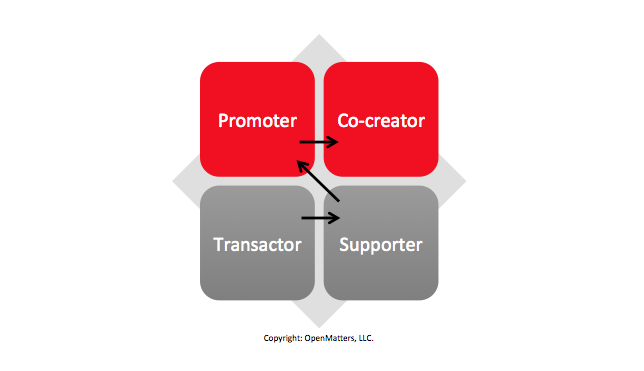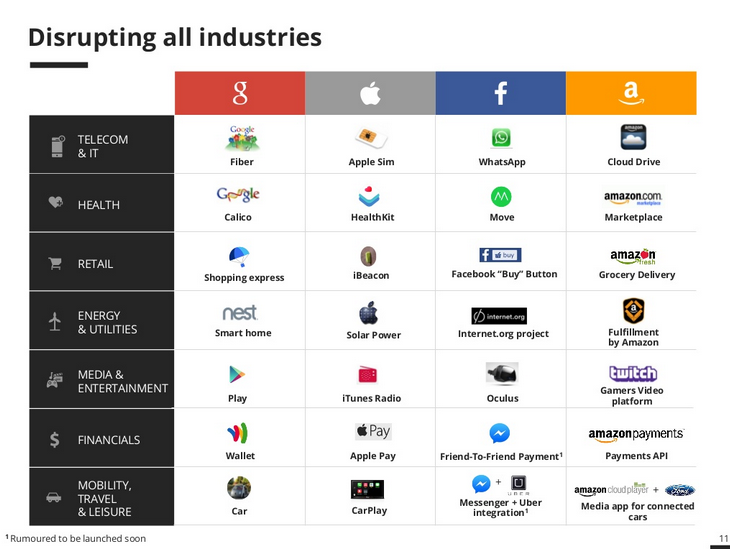Everyone today realizes the importance of digital technology and social media. For most firms, however, the road ends with “likes” on Facebook and promotions on Twitter. According to Barry Libert, Jerry Wind and Megan Beck Fenley, these limited strategies leave a lot of value on the table when customers are looking for a company to “love.” The winners in the market will be those firms that can pivot their business model for great customer intimacy and inclusivity, they write in this opinion piece.
Every morning, like us, you probably pick up your Apple iPad, check your Facebook feed to see what family and friends are up to, and then Google something that catches your eye. If you like what you see, you probably purchase it with your Amazon Prime account and receive it the next day. All we now need is for our iPads to dispense our morning Starbucks coffee and we’ll be happy campers.
For many of us, Google, Apple, Facebook and Amazon (the GAFA four), feel as essential as the air we breathe. It’s hard to imagine our lives — working, socializing, shopping and entertaining — without them.
Sure, we may interact with other companies. But it’s less frequently and with a lot less enthusiasm. We merely “transact” with these other firms. They have not created endearing or profound relationships with us, and we don’t want to share much, if anything, with them. We save all that good stuff for Facebook.
The GAFA four are outstanding in the intimacy that they create with their customers. They make a strong effort to understand the unique characteristics and preferences of each customer and use the insights that they gain to serve the customer better. Further, they see each customer as a complete personality with needs around different facets such as work, play, socializing and self. They serve these needs wholly — and this, in turn, encourages more sharing and openness from their customers.
In short, these four companies are building a long-term, holistic and generous relationship with their customers. It’s almost as if they love us — not like our parents or spouses, of course, but by way of “unselfish, loyal and benevolent concern for the good of another.” And the result? In 2014, Google’s revenue was up 19% year over year, Amazon’s sales were up 20% year over year, Facebook’s revenue was up 58% year over year and Apple’s revenue was up 7%, ending the year with their best-ever quarter.
Likes vs. Love
Traditional brands are trying to join the game and gain that essential-as-air quality. But they find it difficult to move beyond a transactional relationship. Usually, we only see and hear from them when they want something from us. These companies are very focused on whether or not customers are loyal to them, but they rarely consider how loyal they are to their customers. Their actions often seem self-serving; soliciting Facebook “likes” to promote themselves. This short-sighted approach stems from a common view that customers don’t have much to offer beyond what’s in their wallets.
Traditional companies are very focused on whether or not customers are loyal to them, but they rarely consider how loyal they are to their customers.
For example, you have probably purchased many cars over a period of time, but it is unlikely that any car company has offered you a loyalty program that allows you to buy four cars and get the fifth for free. Nor is it likely that they have asked you to partner for the design of their next car — except, perhaps, a company like Local Motors. They probably haven’t asked you for anything other than your purchase, and haven’t offered you anything other than a vehicle. The once-every-few-years transaction you have with a dealer is unlikely to create “love.” A car company that wants a relationship with you would act differently.
For those organizations that take a new perspective and build genuine and mutual relationships with each customer, it is a win-win situation. These organizations move their customers along the spectrum of affinity from “transactors” — who have no relationship beyond the purchase, to “supporters” — who regularly interact with the firm, to “promoters” — who share their enthusiasm for the brand with friends and family, to “co-creators” — who actually feel that they are partners with the organization (Figure 1).

The good news is that your customers are already there, seeking to share and collaborate with corporations. For example, customers are already sharing opinions on Yelp and TripAdvisor; they are helping create advertising for Danone yogurt, designing new Nike shoes, offering products on Etsy and eBay, and creating content for LinkedIn and Facebook. And by doing so, they are offering these companies their skills and assets, plus a great deal of insight into who they are.
Need to Change the Business Model
But most established firms remain hesitant when it comes to this type of customer equality and mutuality. Our research on the business models of the S&P 500 Index companies (based on data from 1972 to 2013) indicates that at present more than 80% of companies employ older business models where customers are valued only for their dollars and not for their assets, insights and contributions. If your organization can break ranks and adopt this new way of thinking and acting, you will see that the more you share with your customers and the more you understand them, the more they will love you.
Some companies are building initiatives and the technological capabilities needed to develop co-creation relationships with their customers — lasting relationships that are mutual and self-reinforcing. Nike, The North Face, Jeld-Wen and many more firms now offer customer co-designed products, and the sharing economy is growing from cars (Uber), to lodging (Airbnb), to clothing (Rent the Runway). Many firms, however, are only building a token Facebook page and Twitter account. In the journey towards “love,” creating a social business is only a small step. The final destination is one where [both] customers and companies enjoy success, fulfillment and shared value.
So, the real question is: “What does it take to love our customers and be loved in return?” The answer: Serve your customers the way they want to be served. Fulfill their needs not just for products and services, but also for connection, community, participation, recognition and fulfillment. Of course, we recognize that customers are not heterogeneous and have unique preferences in how they wish to interact with different companies. What we suggest is that you create opportunities for those customers eager to have a relationship with you.
Changing your relationship with your customers means changing the way you interact with them. Most companies attempt to do this through marketing initiatives and social media. As mentioned above, this is a very superficial approach. The most successful and most loved companies adapt at the level of the business model and find ways to share value creation with their customers.
Changing your relationship with your customers means changing the way you interact with them.
The Winning Moves
Let’s return to the GAFA four, and see how they have created network businesses that expand the customer relationship.
- Google: Google made the decision to make two of its most popular products open source: Chrome (a browser that is open source through Chromium) and Android (an operating system). This allows users to help guide the development and get bug fixes and desired features faster. People love Chrome so much that it dominates the browser market with three times as many users as the next popular browser.
- Apple: Along with its wildly popular products such as the iPhone and iPad, Apple formed a developer network to help outside parties create software for its platforms. This ensures that there is a great market for the apps the customers want, and allows those with an interest to participate. In 2014, 59% of iPhone users described themselves as “blindly loyal” to the platform.
- Facebook: The world’s largest social network, where the users create all of the content, Facebook allows users to communicate with their friends and family and share whatever they want to with the world. In Q1 2015, Facebook had 1.4 billion users, nearly 20% of the world population, and 70% of them interact with Facebook on a daily basis.
- Amazon: The behemoth Internet retailer allows both individuals and companies to sell through its online channel. This increases the selection available to customers and probably also brings down the prices through increased competition. According to the 2014 Harris Poll Reputation Quotient study, Amazon.com had the best reputation among U.S. companies (for the second time), and it also was the leader by way of emotional appeal.
If you would like to join this movement and expand your business model, partner with your customers and cultivate “love,” we recommend a simple, five-step process, PIVOT, to build these capabilities in your own organization:
- Pinpoint: Know your starting place. Gauge customer sentiment and how well you know your customers and how well they know you.
- Identify: Take inventory of the places, if any, where customers contribute to your organization. Take inventory of your customers’ groups and their characteristics.
- Vision: Envision a new future where you partner with your customers in a new business model, allowing them to participate and share in the value.
- Operate: Begin shifting a small amount of your capital (including time, talent, and money) to this new business model. Start small, insulate from the politics of the larger firm, and prepare to iterate.
- Track: Put in place new metrics appropriate for this customer-centered, network effort. Add key performance indicators (KPIs) such as number of interactions (sales or other), number of customer-partners, and value returned to customers, to your standard financial measures. Use these to guide rapid iteration.
Despite their incredible size, the GAFA four are still rapaciously eating up companies and expanding into new industries (see Figure 2, excerpted from FABERNOVEL, GAFAnomics, October 2014). They are gaining more and more attention from, and forging deeper intimacy with, their customers. And it’s not just Google, Apple, Facebook and Amazon that incumbents should be worried about. Their emerging and younger siblings like Uber, Airbnb, Pinterest, Instagram and Alibaba have hundreds of millions of customers the world over that spend a significant time of their day with them.

The stumbling block that most companies encounter on the path to “love” is simple: Leaders believe that “love” belongs at home and not in business. Companies also believe that customer partnerships bring dangerous risks and loss of control. But that old way of thinking now brings its own significant risks as Google, Apple, Facebook and Amazon garner our “love” across an expanding industry profile.
To capture customer attention, organizations need to move beyond their everyday tactics of “faster, better, cheaper.” They also have to elevate their game beyond the current mantra of “delivering a quality experience” or the latest fad, Facebook “likes.” These steps are important, but still insufficient to compete in a world where your competitors know your customers as unique individuals and partner with them to create shared value.
In short, remember this phrase: In a world of likes, “love” matters. Companies and individuals used to believe that our business lives and personal lives are, and must be, separate. But that is no longer true. Cultural changes and technology have broken down these traditional silos, creating an environment where people want to interact with organizations in new and very personal ways. If you don’t believe us, just watch what happens over time to your top and bottom lines as customers contribute their dollars, plus their assets, skills and ideas, to the companies that listen to them, share with them and love them.
Interested in learning more? Take our Customer Type Assessment to help figure out what type of customers your organization has.
Barry Libert is CEO of OpenMatters, an angel investor, digital board member, and senior fellow at Wharton; Jerry Wind is director of the SEI Center and a marketing professor at Wharton; and Megan Beck Fenley is a digital advisor and research associate at OpenMatters. Susan Corso, a leadership consultant with OpenMatters, contributed to this article.


